Waterfall Train Accident: A Case Study of System Failures
VerifiedAdded on 2023/06/06
|9
|2257
|244
Case Study
AI Summary
This case study examines the tragic Waterfall train accident that occurred in 2003 in Australia. The assignment details the accident, which was caused by excessive speed and driver incapacitation, leading to multiple fatalities and injuries. It explores the subsequent investigation by the Ministry of Transport and the Special Commissioner, which identified critical safety management failures, including insufficient medical checkups, failure of the dead man system, and inadequate training. The study highlights the post-disaster policies and implementations proposed, such as routine medical checkups, the introduction of new rolling stock with advanced safety features, and improved communication systems. The analysis emphasizes the importance of learning from the accident to prevent future incidents and underscores the collaborative role of the Australian government and railway corporations in ensuring safety and security through effective measures.
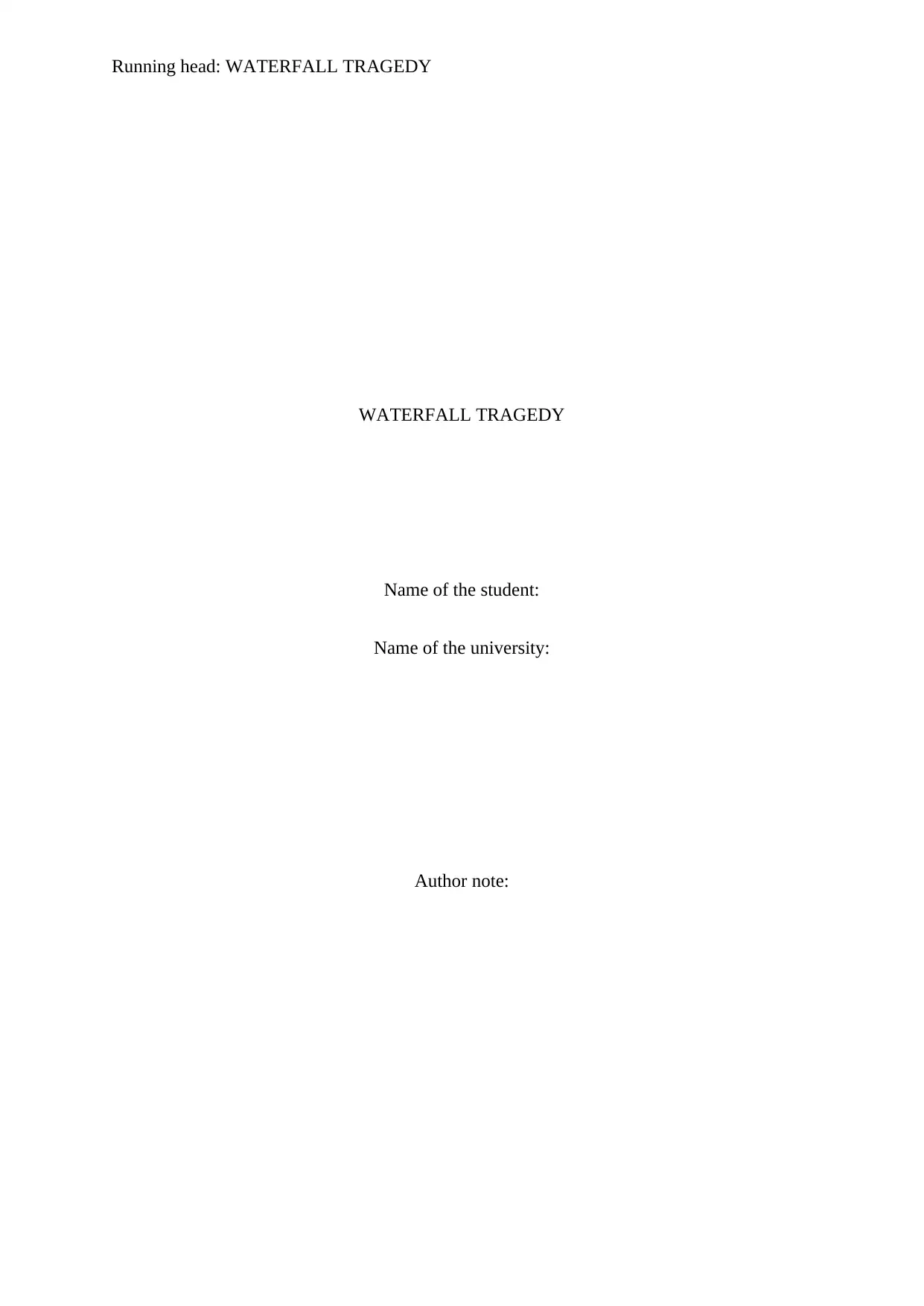
Running head: WATERFALL TRAGEDY
WATERFALL TRAGEDY
Name of the student:
Name of the university:
Author note:
WATERFALL TRAGEDY
Name of the student:
Name of the university:
Author note:
Paraphrase This Document
Need a fresh take? Get an instant paraphrase of this document with our AI Paraphraser
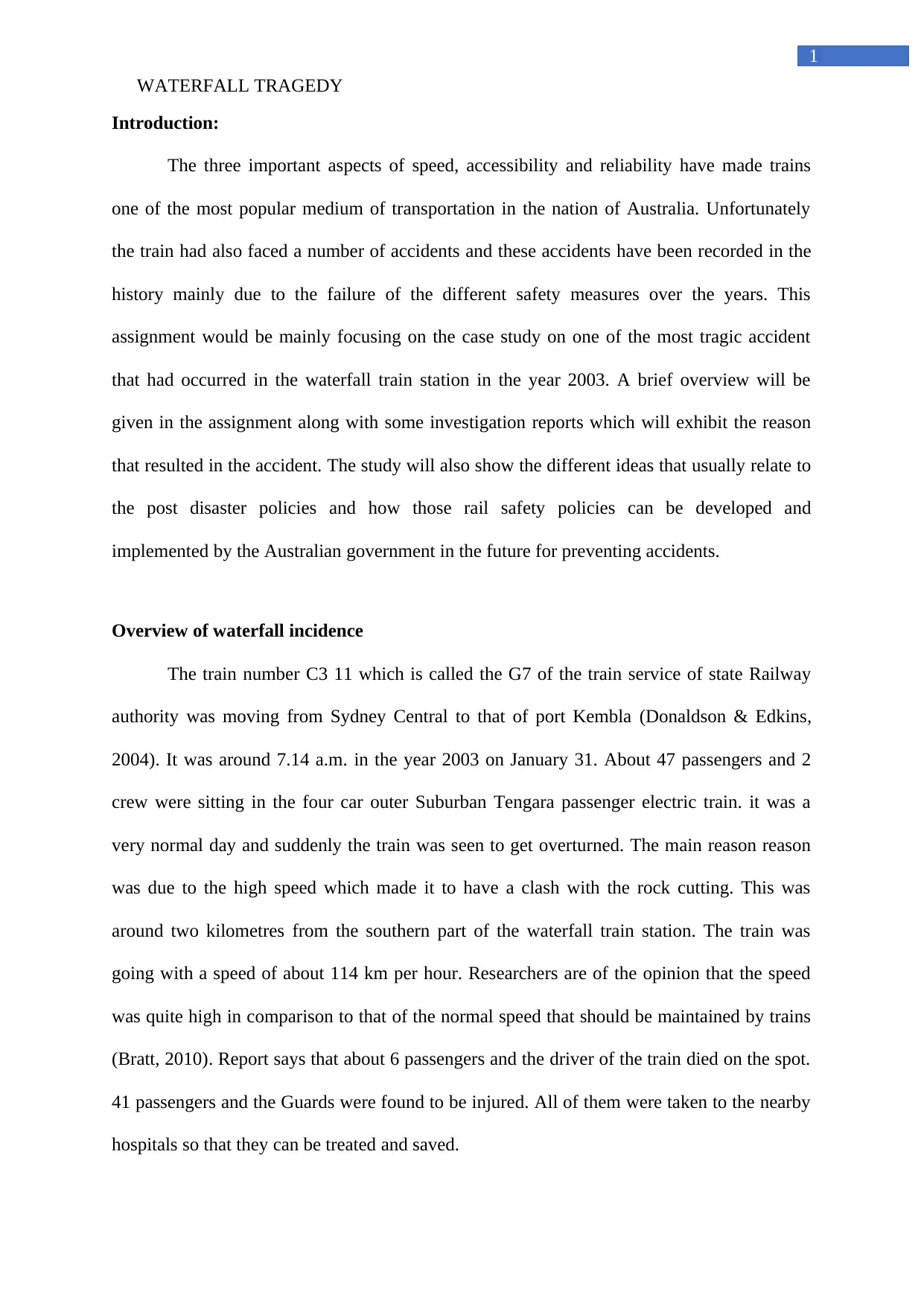
1
WATERFALL TRAGEDY
Introduction:
The three important aspects of speed, accessibility and reliability have made trains
one of the most popular medium of transportation in the nation of Australia. Unfortunately
the train had also faced a number of accidents and these accidents have been recorded in the
history mainly due to the failure of the different safety measures over the years. This
assignment would be mainly focusing on the case study on one of the most tragic accident
that had occurred in the waterfall train station in the year 2003. A brief overview will be
given in the assignment along with some investigation reports which will exhibit the reason
that resulted in the accident. The study will also show the different ideas that usually relate to
the post disaster policies and how those rail safety policies can be developed and
implemented by the Australian government in the future for preventing accidents.
Overview of waterfall incidence
The train number C3 11 which is called the G7 of the train service of state Railway
authority was moving from Sydney Central to that of port Kembla (Donaldson & Edkins,
2004). It was around 7.14 a.m. in the year 2003 on January 31. About 47 passengers and 2
crew were sitting in the four car outer Suburban Tengara passenger electric train. it was a
very normal day and suddenly the train was seen to get overturned. The main reason reason
was due to the high speed which made it to have a clash with the rock cutting. This was
around two kilometres from the southern part of the waterfall train station. The train was
going with a speed of about 114 km per hour. Researchers are of the opinion that the speed
was quite high in comparison to that of the normal speed that should be maintained by trains
(Bratt, 2010). Report says that about 6 passengers and the driver of the train died on the spot.
41 passengers and the Guards were found to be injured. All of them were taken to the nearby
hospitals so that they can be treated and saved.
WATERFALL TRAGEDY
Introduction:
The three important aspects of speed, accessibility and reliability have made trains
one of the most popular medium of transportation in the nation of Australia. Unfortunately
the train had also faced a number of accidents and these accidents have been recorded in the
history mainly due to the failure of the different safety measures over the years. This
assignment would be mainly focusing on the case study on one of the most tragic accident
that had occurred in the waterfall train station in the year 2003. A brief overview will be
given in the assignment along with some investigation reports which will exhibit the reason
that resulted in the accident. The study will also show the different ideas that usually relate to
the post disaster policies and how those rail safety policies can be developed and
implemented by the Australian government in the future for preventing accidents.
Overview of waterfall incidence
The train number C3 11 which is called the G7 of the train service of state Railway
authority was moving from Sydney Central to that of port Kembla (Donaldson & Edkins,
2004). It was around 7.14 a.m. in the year 2003 on January 31. About 47 passengers and 2
crew were sitting in the four car outer Suburban Tengara passenger electric train. it was a
very normal day and suddenly the train was seen to get overturned. The main reason reason
was due to the high speed which made it to have a clash with the rock cutting. This was
around two kilometres from the southern part of the waterfall train station. The train was
going with a speed of about 114 km per hour. Researchers are of the opinion that the speed
was quite high in comparison to that of the normal speed that should be maintained by trains
(Bratt, 2010). Report says that about 6 passengers and the driver of the train died on the spot.
41 passengers and the Guards were found to be injured. All of them were taken to the nearby
hospitals so that they can be treated and saved.
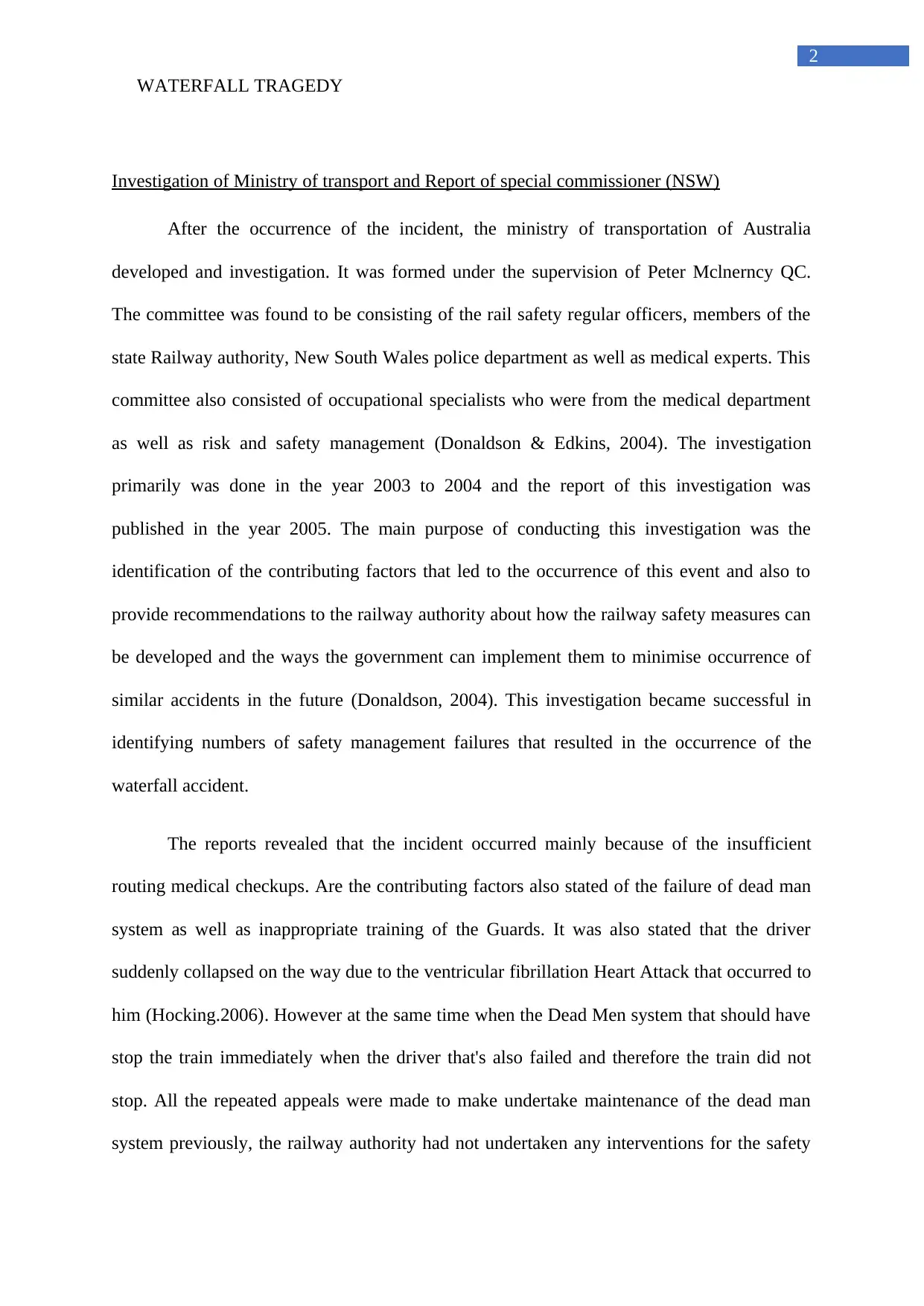
2
WATERFALL TRAGEDY
Investigation of Ministry of transport and Report of special commissioner (NSW)
After the occurrence of the incident, the ministry of transportation of Australia
developed and investigation. It was formed under the supervision of Peter Mclnerncy QC.
The committee was found to be consisting of the rail safety regular officers, members of the
state Railway authority, New South Wales police department as well as medical experts. This
committee also consisted of occupational specialists who were from the medical department
as well as risk and safety management (Donaldson & Edkins, 2004). The investigation
primarily was done in the year 2003 to 2004 and the report of this investigation was
published in the year 2005. The main purpose of conducting this investigation was the
identification of the contributing factors that led to the occurrence of this event and also to
provide recommendations to the railway authority about how the railway safety measures can
be developed and the ways the government can implement them to minimise occurrence of
similar accidents in the future (Donaldson, 2004). This investigation became successful in
identifying numbers of safety management failures that resulted in the occurrence of the
waterfall accident.
The reports revealed that the incident occurred mainly because of the insufficient
routing medical checkups. Are the contributing factors also stated of the failure of dead man
system as well as inappropriate training of the Guards. It was also stated that the driver
suddenly collapsed on the way due to the ventricular fibrillation Heart Attack that occurred to
him (Hocking.2006). However at the same time when the Dead Men system that should have
stop the train immediately when the driver that's also failed and therefore the train did not
stop. All the repeated appeals were made to make undertake maintenance of the dead man
system previously, the railway authority had not undertaken any interventions for the safety
WATERFALL TRAGEDY
Investigation of Ministry of transport and Report of special commissioner (NSW)
After the occurrence of the incident, the ministry of transportation of Australia
developed and investigation. It was formed under the supervision of Peter Mclnerncy QC.
The committee was found to be consisting of the rail safety regular officers, members of the
state Railway authority, New South Wales police department as well as medical experts. This
committee also consisted of occupational specialists who were from the medical department
as well as risk and safety management (Donaldson & Edkins, 2004). The investigation
primarily was done in the year 2003 to 2004 and the report of this investigation was
published in the year 2005. The main purpose of conducting this investigation was the
identification of the contributing factors that led to the occurrence of this event and also to
provide recommendations to the railway authority about how the railway safety measures can
be developed and the ways the government can implement them to minimise occurrence of
similar accidents in the future (Donaldson, 2004). This investigation became successful in
identifying numbers of safety management failures that resulted in the occurrence of the
waterfall accident.
The reports revealed that the incident occurred mainly because of the insufficient
routing medical checkups. Are the contributing factors also stated of the failure of dead man
system as well as inappropriate training of the Guards. It was also stated that the driver
suddenly collapsed on the way due to the ventricular fibrillation Heart Attack that occurred to
him (Hocking.2006). However at the same time when the Dead Men system that should have
stop the train immediately when the driver that's also failed and therefore the train did not
stop. All the repeated appeals were made to make undertake maintenance of the dead man
system previously, the railway authority had not undertaken any interventions for the safety
⊘ This is a preview!⊘
Do you want full access?
Subscribe today to unlock all pages.

Trusted by 1+ million students worldwide

3
WATERFALL TRAGEDY
measure. These had invited the occurrence of the event. Infatuation it is expected of the
Guards to stop the train by applying emergency brake. However the god in the G7 ways to
use his mind either due to depression or due to anxiety (Mclnerney, 2005)
Special commissioner inquiry was also established later on and this was done in order
to detect the safety management system of the railway crops and the South Wales
independent transport safety and reliability regulator. This inquiry stated that there was
complete failure of communication within and between the railway staff and the emergency
team. They were not able to function efficiently during the occurrence of the incident
(Mclnerney,2005). It was also found that the guards were not allowed to use metro net radio
event during the time of any types of emergency. It was also found that proper standard
guidelines and emergency alarm along with equipment within the railway department were
completely absent. Depending upon the basis of the final report, different types of
recommendations were provided on safety management system that would have helped in the
prevention of similar incidents in the future. Regular medical checkups of the railway staff
was made important along with proper training and regular Vigilance of the different types of
activities of the train. In alternative to the dead man system, regular train maintenance and
emergency exit door, effective Communications Railway member safety and different types
of occupational health and safety emergency disaster preparedness also were proposed in the
report.
Post disaster policies and implementations that were proposed
Routine medical check up
It was found that one of the contributing reason behind the train accident at waterfall
was the death of the driver. The report of the inquiry showed the poor medical condition and
standard of the New South Wales Railway authority. The inquiry report provided by the
WATERFALL TRAGEDY
measure. These had invited the occurrence of the event. Infatuation it is expected of the
Guards to stop the train by applying emergency brake. However the god in the G7 ways to
use his mind either due to depression or due to anxiety (Mclnerney, 2005)
Special commissioner inquiry was also established later on and this was done in order
to detect the safety management system of the railway crops and the South Wales
independent transport safety and reliability regulator. This inquiry stated that there was
complete failure of communication within and between the railway staff and the emergency
team. They were not able to function efficiently during the occurrence of the incident
(Mclnerney,2005). It was also found that the guards were not allowed to use metro net radio
event during the time of any types of emergency. It was also found that proper standard
guidelines and emergency alarm along with equipment within the railway department were
completely absent. Depending upon the basis of the final report, different types of
recommendations were provided on safety management system that would have helped in the
prevention of similar incidents in the future. Regular medical checkups of the railway staff
was made important along with proper training and regular Vigilance of the different types of
activities of the train. In alternative to the dead man system, regular train maintenance and
emergency exit door, effective Communications Railway member safety and different types
of occupational health and safety emergency disaster preparedness also were proposed in the
report.
Post disaster policies and implementations that were proposed
Routine medical check up
It was found that one of the contributing reason behind the train accident at waterfall
was the death of the driver. The report of the inquiry showed the poor medical condition and
standard of the New South Wales Railway authority. The inquiry report provided by the
Paraphrase This Document
Need a fresh take? Get an instant paraphrase of this document with our AI Paraphraser
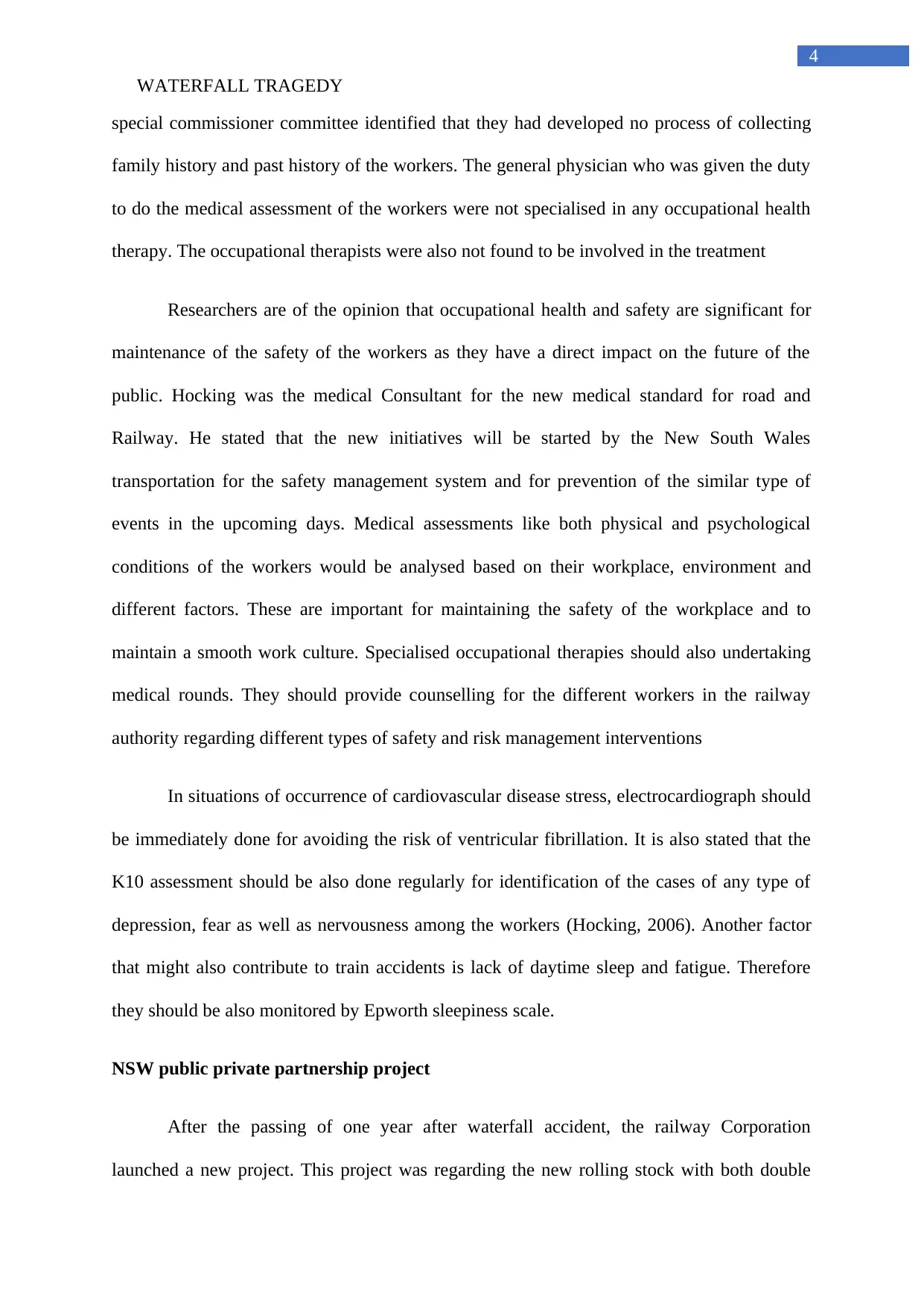
4
WATERFALL TRAGEDY
special commissioner committee identified that they had developed no process of collecting
family history and past history of the workers. The general physician who was given the duty
to do the medical assessment of the workers were not specialised in any occupational health
therapy. The occupational therapists were also not found to be involved in the treatment
Researchers are of the opinion that occupational health and safety are significant for
maintenance of the safety of the workers as they have a direct impact on the future of the
public. Hocking was the medical Consultant for the new medical standard for road and
Railway. He stated that the new initiatives will be started by the New South Wales
transportation for the safety management system and for prevention of the similar type of
events in the upcoming days. Medical assessments like both physical and psychological
conditions of the workers would be analysed based on their workplace, environment and
different factors. These are important for maintaining the safety of the workplace and to
maintain a smooth work culture. Specialised occupational therapies should also undertaking
medical rounds. They should provide counselling for the different workers in the railway
authority regarding different types of safety and risk management interventions
In situations of occurrence of cardiovascular disease stress, electrocardiograph should
be immediately done for avoiding the risk of ventricular fibrillation. It is also stated that the
K10 assessment should be also done regularly for identification of the cases of any type of
depression, fear as well as nervousness among the workers (Hocking, 2006). Another factor
that might also contribute to train accidents is lack of daytime sleep and fatigue. Therefore
they should be also monitored by Epworth sleepiness scale.
NSW public private partnership project
After the passing of one year after waterfall accident, the railway Corporation
launched a new project. This project was regarding the new rolling stock with both double
WATERFALL TRAGEDY
special commissioner committee identified that they had developed no process of collecting
family history and past history of the workers. The general physician who was given the duty
to do the medical assessment of the workers were not specialised in any occupational health
therapy. The occupational therapists were also not found to be involved in the treatment
Researchers are of the opinion that occupational health and safety are significant for
maintenance of the safety of the workers as they have a direct impact on the future of the
public. Hocking was the medical Consultant for the new medical standard for road and
Railway. He stated that the new initiatives will be started by the New South Wales
transportation for the safety management system and for prevention of the similar type of
events in the upcoming days. Medical assessments like both physical and psychological
conditions of the workers would be analysed based on their workplace, environment and
different factors. These are important for maintaining the safety of the workplace and to
maintain a smooth work culture. Specialised occupational therapies should also undertaking
medical rounds. They should provide counselling for the different workers in the railway
authority regarding different types of safety and risk management interventions
In situations of occurrence of cardiovascular disease stress, electrocardiograph should
be immediately done for avoiding the risk of ventricular fibrillation. It is also stated that the
K10 assessment should be also done regularly for identification of the cases of any type of
depression, fear as well as nervousness among the workers (Hocking, 2006). Another factor
that might also contribute to train accidents is lack of daytime sleep and fatigue. Therefore
they should be also monitored by Epworth sleepiness scale.
NSW public private partnership project
After the passing of one year after waterfall accident, the railway Corporation
launched a new project. This project was regarding the new rolling stock with both double

5
WATERFALL TRAGEDY
deck car and single deck car sheet. Reliance rail was seen to get the bid. the rail Corporation
was being called the Sydney train, and the Sydney train and Reliance train worked together
for designing new trains. This helped in directly enhancing the safety as well as the security
of the railway systems (Ramanathan,2016). Ultimately, the Waratah train was introduced.
This had the special technological characteristics and helped in upgrading the safety of not
only the passengers but also the crew. The Waratah train also consisted of an automatic air
conditioner that prevented suffocation and fatigue of people.
There was also addition of the LED light and comfortable sheet. Emergency help
points for the security and safety were present in each of the cabin from where each of the
passengers could directly talk with the guard. There were About 96 CCTV camera inside the
train so that the different activities of the passengers as well as that of the workers could be
observed directly by different railway department. Electronic Screen was fitted in each of the
stops and this helped in providing more details regarding the train (McInerney, 2001). The
different types of Walkthrough were also present so that different passengers can easily move
from one carriage to another in case of emergency. Emergency fire detection device as well
as the fire extinguisher also was properly placed in case of crisis.
Communication:
It is high time for the NSW Railway authority to learn not only from the incident of
the waterfall accident but also from the Glenbrook accidents that occurred on December 2
1999. The accident that took place in the Glenbrook incident was due to the lack of
communication and lack of signal. Special Commission recommendations were provided
which stated that there should be excellent railway network that should have signet telephone.
That helps in properly communicating within the department. Different types of safety
WATERFALL TRAGEDY
deck car and single deck car sheet. Reliance rail was seen to get the bid. the rail Corporation
was being called the Sydney train, and the Sydney train and Reliance train worked together
for designing new trains. This helped in directly enhancing the safety as well as the security
of the railway systems (Ramanathan,2016). Ultimately, the Waratah train was introduced.
This had the special technological characteristics and helped in upgrading the safety of not
only the passengers but also the crew. The Waratah train also consisted of an automatic air
conditioner that prevented suffocation and fatigue of people.
There was also addition of the LED light and comfortable sheet. Emergency help
points for the security and safety were present in each of the cabin from where each of the
passengers could directly talk with the guard. There were About 96 CCTV camera inside the
train so that the different activities of the passengers as well as that of the workers could be
observed directly by different railway department. Electronic Screen was fitted in each of the
stops and this helped in providing more details regarding the train (McInerney, 2001). The
different types of Walkthrough were also present so that different passengers can easily move
from one carriage to another in case of emergency. Emergency fire detection device as well
as the fire extinguisher also was properly placed in case of crisis.
Communication:
It is high time for the NSW Railway authority to learn not only from the incident of
the waterfall accident but also from the Glenbrook accidents that occurred on December 2
1999. The accident that took place in the Glenbrook incident was due to the lack of
communication and lack of signal. Special Commission recommendations were provided
which stated that there should be excellent railway network that should have signet telephone.
That helps in properly communicating within the department. Different types of safety
⊘ This is a preview!⊘
Do you want full access?
Subscribe today to unlock all pages.

Trusted by 1+ million students worldwide
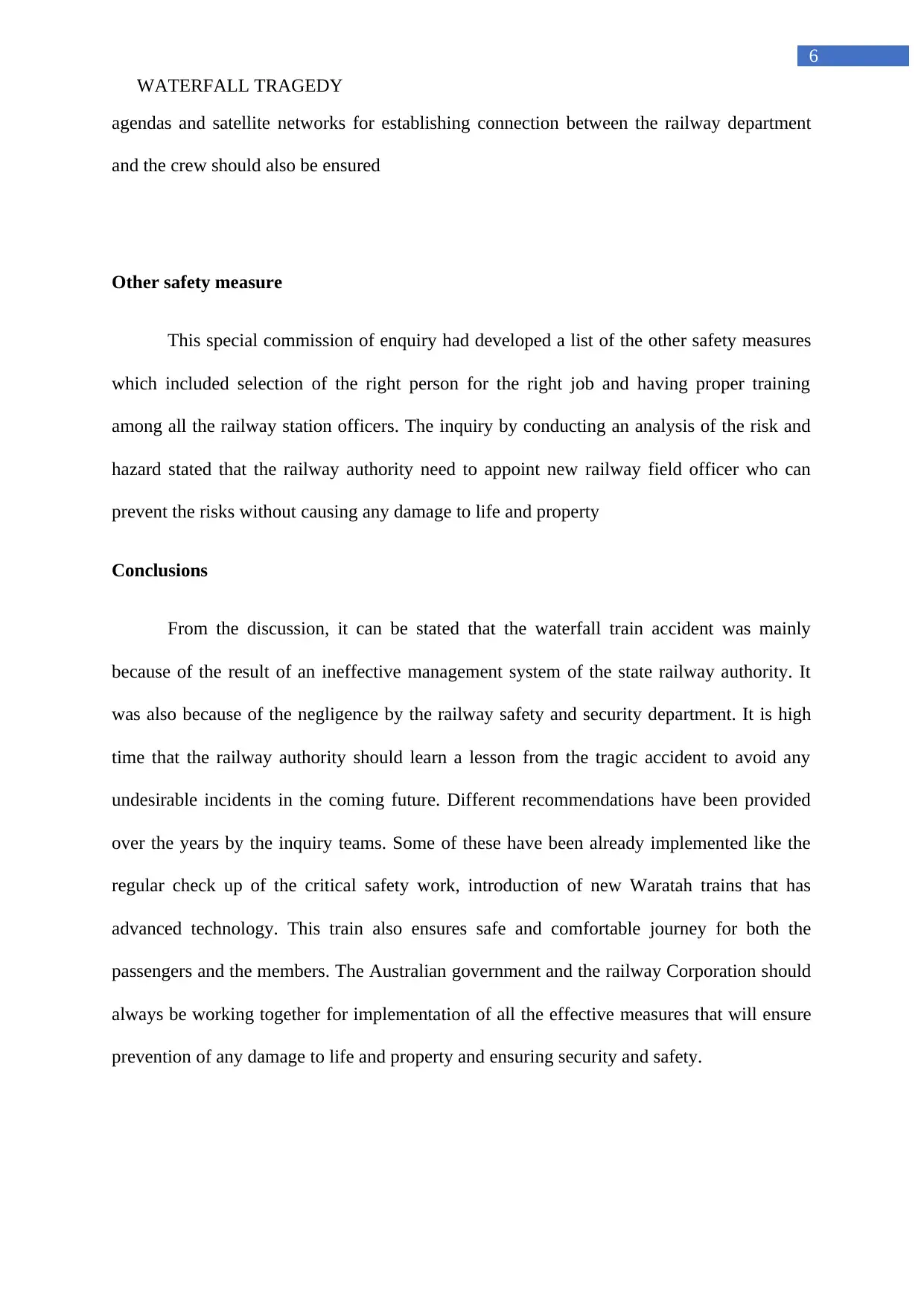
6
WATERFALL TRAGEDY
agendas and satellite networks for establishing connection between the railway department
and the crew should also be ensured
Other safety measure
This special commission of enquiry had developed a list of the other safety measures
which included selection of the right person for the right job and having proper training
among all the railway station officers. The inquiry by conducting an analysis of the risk and
hazard stated that the railway authority need to appoint new railway field officer who can
prevent the risks without causing any damage to life and property
Conclusions
From the discussion, it can be stated that the waterfall train accident was mainly
because of the result of an ineffective management system of the state railway authority. It
was also because of the negligence by the railway safety and security department. It is high
time that the railway authority should learn a lesson from the tragic accident to avoid any
undesirable incidents in the coming future. Different recommendations have been provided
over the years by the inquiry teams. Some of these have been already implemented like the
regular check up of the critical safety work, introduction of new Waratah trains that has
advanced technology. This train also ensures safe and comfortable journey for both the
passengers and the members. The Australian government and the railway Corporation should
always be working together for implementation of all the effective measures that will ensure
prevention of any damage to life and property and ensuring security and safety.
WATERFALL TRAGEDY
agendas and satellite networks for establishing connection between the railway department
and the crew should also be ensured
Other safety measure
This special commission of enquiry had developed a list of the other safety measures
which included selection of the right person for the right job and having proper training
among all the railway station officers. The inquiry by conducting an analysis of the risk and
hazard stated that the railway authority need to appoint new railway field officer who can
prevent the risks without causing any damage to life and property
Conclusions
From the discussion, it can be stated that the waterfall train accident was mainly
because of the result of an ineffective management system of the state railway authority. It
was also because of the negligence by the railway safety and security department. It is high
time that the railway authority should learn a lesson from the tragic accident to avoid any
undesirable incidents in the coming future. Different recommendations have been provided
over the years by the inquiry teams. Some of these have been already implemented like the
regular check up of the critical safety work, introduction of new Waratah trains that has
advanced technology. This train also ensures safe and comfortable journey for both the
passengers and the members. The Australian government and the railway Corporation should
always be working together for implementation of all the effective measures that will ensure
prevention of any damage to life and property and ensuring security and safety.
Paraphrase This Document
Need a fresh take? Get an instant paraphrase of this document with our AI Paraphraser
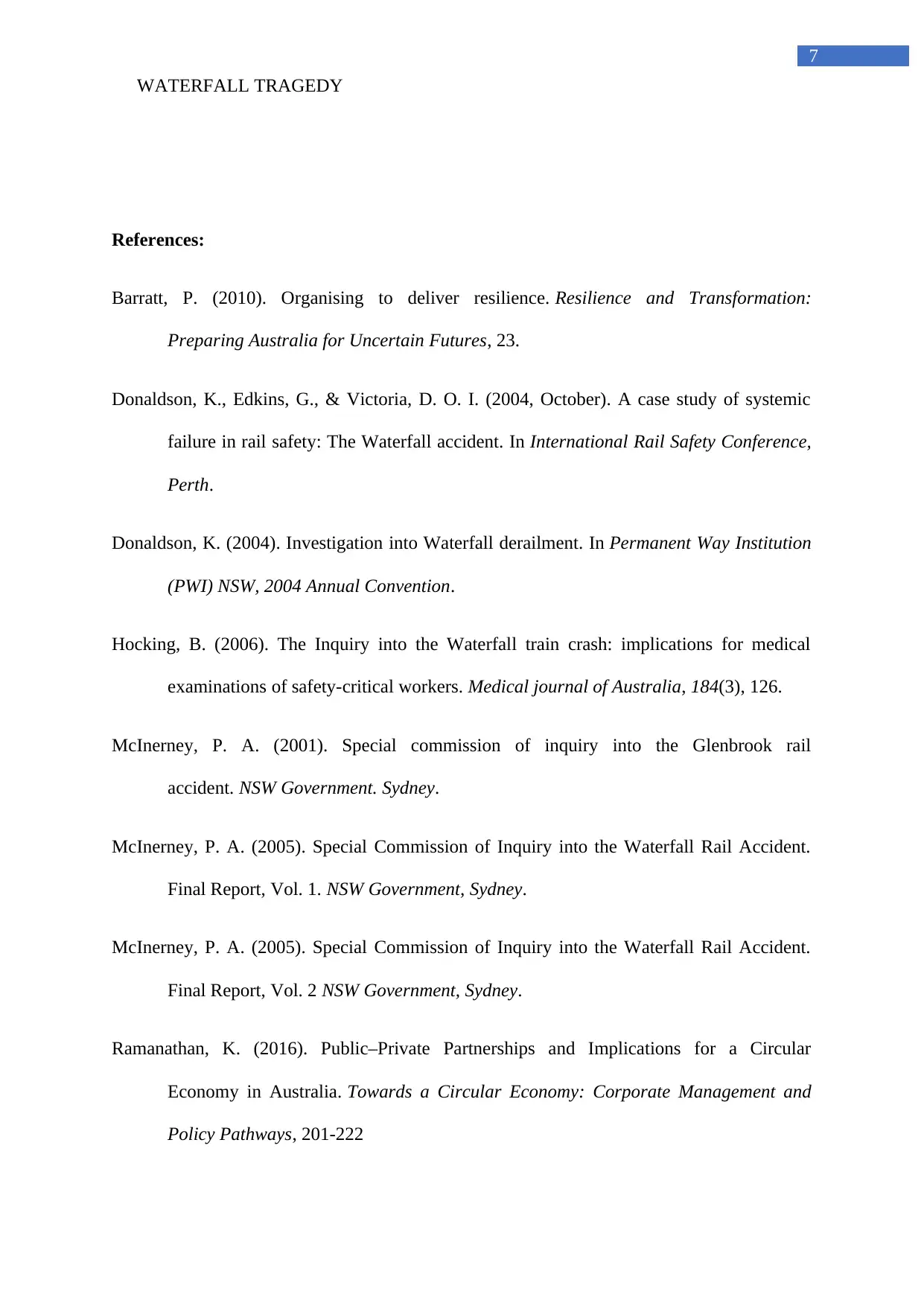
7
WATERFALL TRAGEDY
References:
Barratt, P. (2010). Organising to deliver resilience. Resilience and Transformation:
Preparing Australia for Uncertain Futures, 23.
Donaldson, K., Edkins, G., & Victoria, D. O. I. (2004, October). A case study of systemic
failure in rail safety: The Waterfall accident. In International Rail Safety Conference,
Perth.
Donaldson, K. (2004). Investigation into Waterfall derailment. In Permanent Way Institution
(PWI) NSW, 2004 Annual Convention.
Hocking, B. (2006). The Inquiry into the Waterfall train crash: implications for medical
examinations of safety-critical workers. Medical journal of Australia, 184(3), 126.
McInerney, P. A. (2001). Special commission of inquiry into the Glenbrook rail
accident. NSW Government. Sydney.
McInerney, P. A. (2005). Special Commission of Inquiry into the Waterfall Rail Accident.
Final Report, Vol. 1. NSW Government, Sydney.
McInerney, P. A. (2005). Special Commission of Inquiry into the Waterfall Rail Accident.
Final Report, Vol. 2 NSW Government, Sydney.
Ramanathan, K. (2016). Public–Private Partnerships and Implications for a Circular
Economy in Australia. Towards a Circular Economy: Corporate Management and
Policy Pathways, 201-222
WATERFALL TRAGEDY
References:
Barratt, P. (2010). Organising to deliver resilience. Resilience and Transformation:
Preparing Australia for Uncertain Futures, 23.
Donaldson, K., Edkins, G., & Victoria, D. O. I. (2004, October). A case study of systemic
failure in rail safety: The Waterfall accident. In International Rail Safety Conference,
Perth.
Donaldson, K. (2004). Investigation into Waterfall derailment. In Permanent Way Institution
(PWI) NSW, 2004 Annual Convention.
Hocking, B. (2006). The Inquiry into the Waterfall train crash: implications for medical
examinations of safety-critical workers. Medical journal of Australia, 184(3), 126.
McInerney, P. A. (2001). Special commission of inquiry into the Glenbrook rail
accident. NSW Government. Sydney.
McInerney, P. A. (2005). Special Commission of Inquiry into the Waterfall Rail Accident.
Final Report, Vol. 1. NSW Government, Sydney.
McInerney, P. A. (2005). Special Commission of Inquiry into the Waterfall Rail Accident.
Final Report, Vol. 2 NSW Government, Sydney.
Ramanathan, K. (2016). Public–Private Partnerships and Implications for a Circular
Economy in Australia. Towards a Circular Economy: Corporate Management and
Policy Pathways, 201-222

8
WATERFALL TRAGEDY
WATERFALL TRAGEDY
⊘ This is a preview!⊘
Do you want full access?
Subscribe today to unlock all pages.

Trusted by 1+ million students worldwide
1 out of 9
Related Documents
Your All-in-One AI-Powered Toolkit for Academic Success.
+13062052269
info@desklib.com
Available 24*7 on WhatsApp / Email
![[object Object]](/_next/static/media/star-bottom.7253800d.svg)
Unlock your academic potential
Copyright © 2020–2025 A2Z Services. All Rights Reserved. Developed and managed by ZUCOL.





